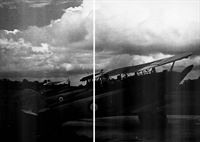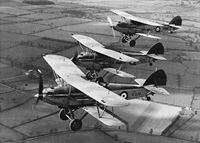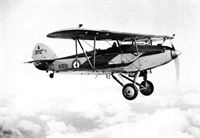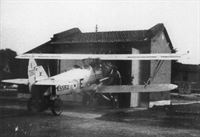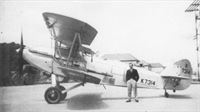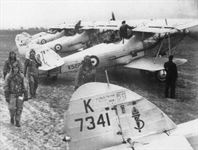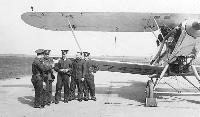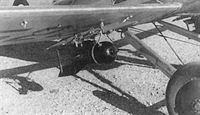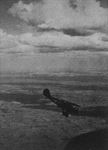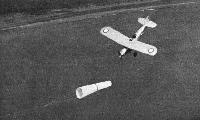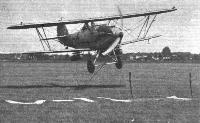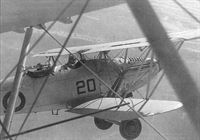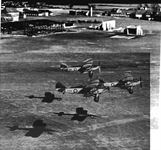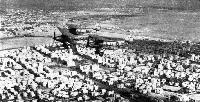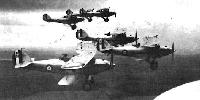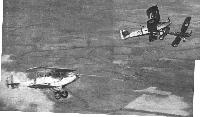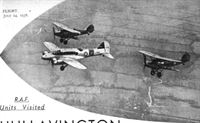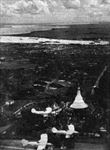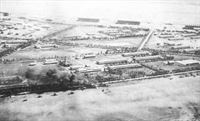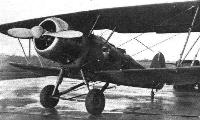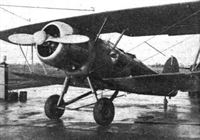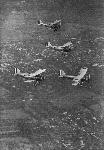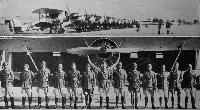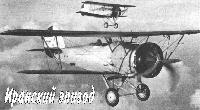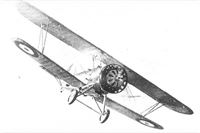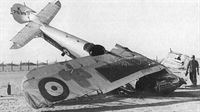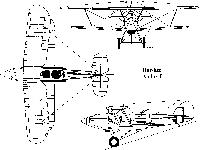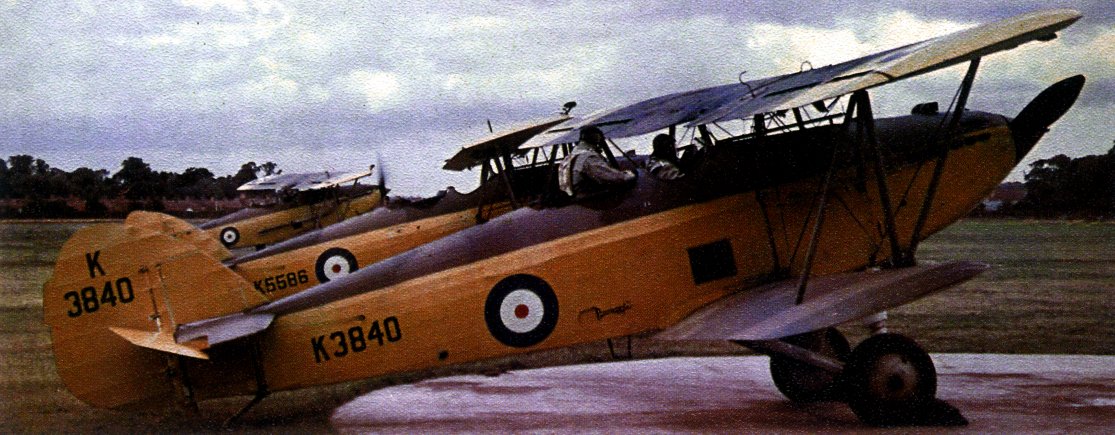
Описание
Страна : Великобритания
Год : 1931
Двухместный самолет взаимодействия с армией
Варианты
- Hawker - Hart - 1928 - Великобритания
- Hawker - Osprey - 1930 - Великобритания
- Hawker - Audax - 1931 - Великобритания
- Hawker - Demon - 1932 - Великобритания
- Hawker - Hardy - 1934 - Великобритания
- Hawker - Hind - 1934 - Великобритания
- Hawker - PV.4 - 1934 - Великобритания
- Hawker - Hartbees - 1935 - Великобритания
- Hawker - Hector - 1936 - Великобритания
Audax
Самолет взаимодействия с сухопутными войсками. Одномоторный цельнометаллический биплан с неубирающимся шасси. Создан на базе легкого бомбардировщика "Харт" конструкторами фирмы "Х.Г. Хаукер инджиниринг компани" (впоследствии "Хаукер эйркрафт") во главе с С. Кэммом. Опытный образец, переделанный из серийного "Харта", испытывался в июне 1931 г. В декабре того же года началось серийное производство самолета "Харт спешиэл", впоследствии переименованного в "Одэкс". Серийный выпуск осуществлялся на заводах "Хаукер" в кингстоне и Бруклендсе, а также по лицензии фирмами "А.В. Роу", "Уэстленд", "Бристоль", "Глостер" и авиазаводом в Дошан-Тепе (Иран). Всего построено 626 экз.
Экипаж самолета - 2 чел. Вооружение 2x7,69, бомбы до 80 кг (в боевых условиях до 227 кг). Двигатель - в зависимости от модификации. "Одэкс" состоял на вооружении в Великобритании с января 1932 г., в Иране и Ираке - с 1933 г., в Египте -с 1937 г., в ЮАС - с 1940 г.
Основные серийные модификации:
- "Харт спешиэл" с мотором "Кестрел" IB3;
- "Одэкс" I с мотором "Кестрел" X;
- "Одэкс" I с мотором "Кестрел" IB5 - для Индии;
- "Одэкс" I с мотором "Кестрел" V - для Сингапура;
- "Одэкс" с мотором R-1690-S2B1-G - для Ирана имели увеличенное вертикальное оперение от морского разведчика "Оспри";
- "Одэкс" с мотором "Пегасус" IIM/IIM2 - для Ирана, вертикальное оперение также от "Оспри";
- "Одэкс" ("Ниср") с мотором "Персеус" IIM2/VIP8 и вертикальным оперением от "Оспри" - для Ирака;
- "Одэкс" с мотором "Пантер" VIA/X, вертикальным оперением от "Оспри", козырьком задней кабины, металлическими винтами, хвостовым колесом вместо костыля, пневматиками низкого давления - для Египта.
Производство самолета прекращено в Великобритании в мае 1937 г., в Иране - в 1940 г.
В метрополии "Одэкс" начал сниматься с вооружения строевых частей с конца 1937 г. и переводиться в школы или в колонии. Впервые эти самолеты были использованы в бою как разведчики в июне 1940 г. в Британском Сомали против итальянских войск. Действовали там до марта 1941 г, после чего были отведены в Родезию и переданы в авиашколы. В апреле - мае 1941 г. "одэксы" применялись обеими сторонами как легкие дневные бомбардировщики в Ираке во время мятежа Рашида Али. В частности, английские машины вывели из строя оружейный завод в Эль-Мусайиб.
В августе того же года иранские самолеты бомбили и обстреливали английские колонны, продвигавшиеся по югу Ирана в районах Бендер-Шахпура, Хафа-Кель и Ханикин. На севере страны некоторое количество "одэксов" иранского производства стало трофеями Красной армии. Два трофейных самолета потом эксплуатировали подразделения ГВФ в Закавказье. На индо-бирманской границе "одэксы" вели патрулирование до конца 1942 г. В Англии эти самолеты служили как учебно-тренировочные и как буксировщики учебных планеров. Окончательно были сняты с вооружения Королевских ВВС в октябре 1944 г. В том же году от них избавились ВВС ЮАС. Иракские машины все были уничтожены в 1941 г. В Иране последние "одэксы" летали до 1946 г.
"Одэкс" I||
Размах:||11,35 м
Длина:||8,85 м
Моторы, количество х мощность:||1x525 л.с.
Взлетная масса, максимальная:||2070 кг
Максимальная скорость:||272 км/ч
Практический потолок:||6550 м
Дальность:||600 км
Описание:
- Audax
- Hawker Audax
Фотографии
-
Авиация и Время 1999-03 / А.Котлобовский - За полвека до "Бури в пустыне" /Аэроархив/
Регистрационный номер: K7518 Hawker Audax 4-й авиашколы ВВС Великобритании, а/б Хаббания, май 1941г.
-
Авиация и Время 1999-03 / А.Котлобовский - За полвека до "Бури в пустыне" /Аэроархив/
Hawker Nisr из 1-й АЭ ВВС Ирака, а/б Мосул, май 1941г.
-
Мировая Авиация 152
В Ираке самолеты Audax получили местное обозначение Nisr. 34 машины были поставлены с двигателями Bristol Pegasus.
-
Моделист-Конструктор Ближние разведчики, корректировщики и штурмовики Второй мировой войны
Регистрационный номер: K5586 [2] Английские самолеты взаимодействия с сухопутными войсками Хаукер "Одэкс" в довоенной окраске
Другие самолёты на фотографии: Hawker Hart - Великобритания - 1928
-
Aeroplane Monthly 1989-01
Регистрационный номер: K5586 [2] Pre-war colour photographs are uncommon and so we are particularly grateful to L. A. Hutton of Pyrford, Woking in Surrey for the very rare shot at right of Hawker Harts and Audaxes taken at Hanworth in the late Thirties.
In the foreground is Hawker Hart K3840, one of 47 delivered to the RAF by Vickers Ltd between February and March 1934. Initially retained by the manufacturers, K3840 was later issued to 142 Sqn. It subsequently passed to 5 ERFTS, based at Hanworth, and then to 2 FTS at Bristol. It was struck off RAF charge in July 1940.
Behind the Hart is Hawker Audax K5586, part of a batch delivered to the RAF by Avro during March and April 1937. Delivered first to 2 Sqn, K5586 passed to 615 Sqn and then met up with Hart K3840 at Hanworth with 5 ERFTS. Later the Audax passed to 3 FTS before being delivered to the South African Air Force in November 1940.Другие самолёты на фотографии: Hawker Hart - Великобритания - 1928
-
Air Enthusiast 2001-11 / K.Wixey - Hart Of The Matter (1)
Регистрационный номер: K1438 It took just over a week to convert Hart K1438 into the prototype Audax in May 1931.
-
Air Enthusiast 2001-11 / K.Wixey - Hart Of The Matter (1)
Регистрационный номер: K1995 First production Hawker Audax I K1995 at Brooklands, from where it made its first flight on December 29, 1931.
-
Aeroplane Monthly 1990-11 / Personal album. Military
Регистрационный номер: K2001 Two Hawker Audax two-seat army co-operation biplanes of 4 Squadron. The nearer aircraft, K2001, served with Nos 4, 13 and 211 Sqns and then passed to Nos 15 ERFTS, 3 FTS and 1 FTS, finally being struck off RAF charge in September 1941.
-
Air Enthusiast 2001-11 / K.Wixey - Hart Of The Matter (1)
Регистрационный номер: K2012 [7] P W S 'George' Bulman in Audax K2012, one of a batch of 40 delivered between December 1931 and June 1932. Note the message hook deployed.
-
Мировая Авиация 202
Регистрационный номер: K2012 [7] Audax - взаимодействие с Армией. В 1931 году британские ВВС сформулировали требования к преемнику Armstrong-Whitworth Atlas, самолету для взаимодействия с сухопутными войсками. Поскольку Hart уже показал свои возможности, то его решили использовать в новом качестве, и заказали 40 самолетов. От стандартных Hart они отличались удлиненными выхлопными патрубками, улучшившими летчику обзор вниз. На шасси установили поднимаемый крюк (на фотографии) для приема корреспонденции с земли без посадки. В 1932 году новым вариантом вооружили эскадрилью IV(AC). Следующие заказы (построено более 400 самолетов) разместили на заводах компаний "A.V. Roe", "Bristol", "Gloster", "Westland" и самой "Hawker". Самолеты эксплуатировались в метрополии, Индии, на Ближнем Востоке, экспортировались в Персию (с моторами P&W Hornet) и Ирак. В ходе укрупнения состава британских ВВС в середине 1930-х годов часть Audax передали в авиационные училища. На вооружении некоторых заморских частей первой линии Audax оставались до 1941 года.
-
Aeroplane Monthly 1983-12 / J.Read - Fledgling (2)
Регистрационный номер: K2012 [7] The 'Art with the 'ook, the Jack-of-all-trades and mainstay of the Army Co-operation units during the mid-Thirties. The Audax could be distinguished externally from the Hart by its message-collecting hook and long exhausts.
Flt Lt “George” Bulman flying Hawker Audax K2012 from Brooklands in June 1932. -
Flight 1935-02 / Flight Advertisements
Регистрационный номер: K2012 [7] HAWKER AUDAX : Army co-operation (Kestrel X engine - 550 h.p. at 3,000ft.); span, 37ft. 3in.; gross weight, 4,381 lb.; max. speed, 170 m.p.h. at 3,280ft. A machine possessing all the qualities required for Army Co-operation work, accurate manoeuvrability through the whole speed range, a good climb and a high top speed.
-
Flight 1935-12 / Flight
Регистрационный номер: K2012 [7] The Hawker Audax (Kestrel IB or X) is intended for army co-operation.
-
Flight 1933-09 / Flight Advertisements
Регистрационный номер: K2012 [7] Hawker Audax fitted with Rolls-Royce'Kestrel" Engine
-
Air Enthusiast 2007-07 / A.Thomas - Fledgling Eagles /Air forces/
Регистрационный номер: K3108 The first four Audax to arrive at Cranborne for the SRAU initially retained their RAF serials and all were fitted with underwing panniers
-
Aeroplane Monthly 1976-03 / H.Levy - Middle East exiles
Регистрационный номер: K3124 [2] Hawker Audax K3124 at El Kabrit, Egypt, early in 1943.
-
Aeroplane Monthly 1976-03 / H.Levy - Middle East exiles
Регистрационный номер: K3124 [2] Hawker Audax K3124 at El Kabrit, Egypt, early in 1943. The Audax was an army co-operation variant of the Hart, but by the time this picture was taken the type was relegated to "general dogsbody" duties.
-
Flight 1934-11 / Flight
Регистрационный номер: K3685 A LINE-UP: Hawker "Audax" machines (Rolls Royce ''Kestrel" engines) of the School of Army Co-operation.
-
Flight 1935-03 / Flight Advertisements
Регистрационный номер: K3697 Aiding the Infantry: An "Audax" picking up a message. In field conditions the two posts between which the message cord is extended might be replaced by rifles with fixed bayonets driven into the ground.
-
Aeroplane Monthly 1979-06 / C.Lamb - Return to Papplewick
Регистрационный номер: K3698 [5] Hawker Audax K3698 was the actual aircraft in which the author's friend Plt Off Ronnie Morgan Elms, was killed at Old Sarum on May 29, 1937. This photograph was taken in September 1934, when the aircraft was with No 16 Squadron, Old Sarum.
-
Flight 1935-06 / Flight
Регистрационный номер: K3698 [5] A standard type, which equips the majority of army co-operation squadrons, is the "Kestrel"-engined "Audax".
-
Flight 1935-01 / Flight
Регистрационный номер: K3692 [5], K3698 [5] Группа Audax из 16-й эскадрильи взаимодействия с армией Королевских ВВС. Самолеты этого типа несли службу как в самой Британии, так и на Ближнем Востоке и в Африке.
THE ARMY'S OPTIC NERVE: A flight of three Hawker "Audax" machines (Rolls-Royce "Kestrel"), of No. 16 (Army Co-operation) Squadron, which is stationed at Old Sarum. -
Aeroplane Monthly 1983-11 / J.Read - Fledgling (1)
Регистрационный номер: K3692 [5], K3698 [5], K3701 [2] Three Hawker Audaxes of 16 Sqn up from Old Sarum in September 1934.
-
Aeroplane Monthly 1981-09 / T.Dudgeon - The Habbaniya campaign (1)
Регистрационный номер: K3692 [5], K3698 [5], K3701 [2] A formation of three Hawker Audax Is of No 16 Sqn from Old Sarum photographed during September, 1934. Aircraft from this same production batch were on the strength of No 4 FTS.
Audax K3701, K3698 and K3692 wearing the black fuselage band of No 16 Squadron, Old Sarum. The Audax had a Hart-type rear cockpit, extra-long exhaust pipes and, being an Army Co-op. type, an underfuselage hook for picking up messages -
Air-Britain Aeromilitaria 1986-04
Регистрационный номер: K3695, K3711, K7425 [3] Audaxes of No.9 FTS
-
Air-Britain Aeromilitaria 1980-02
Регистрационный номер: K3712 Hawker Audax I K3712 of No.18 Elementary & Reserve Flying Training School, Fair Oaks
-
Air Enthusiast 2001-11 / K.Wixey - Hart Of The Matter (1)
Регистрационный номер: K4838 Standing on Gloster's Hucclecote airfield, the first of 25 Audax Indias, K4838.
-
Aeroplane Monthly 1984-05 / Personal album
Регистрационный номер: K4862 Three RAF aircraft at Lahore in 1938. On the right is Airspeed Envoy N9107 of the Delhi Communication Flight. In the centre is Hawker Audax K4862, which flew with Nos 20 and 39 Sqns before diving into the ground at Risalpur in May 1939. At left is Envoy N9018, also of the Delhi Communications Flight and previously G-AFJE. This aircraft crashed at Mingaladon in Rangoon in February 1942.
Другие самолёты на фотографии: Airspeed Envoy / AS.6 - Великобритания - 1934
-
Aeroplane Monthly 1984-05 / N.Hearn-Phillips - Pilot's progress
Регистрационный номер: K5132 The Hawker Audax differed from the Hart mainly by way of the rear cockpit, which was fitted out for an observer/gunner. Each exercise on the advanced course was carried out by a pair of pilots acting alternately as pilot and observer.
-
Flight 1939-02 / Flight
Регистрационный номер: K5142 S.S.V.A.F. Audaxes at Mergui aerodrome, Burma. The natives squatting in the foreground are Burmese priests.
-
Aeroplane Monthly 1990-07 / J.Meadows - Flying for fun (2)
Регистрационный номер: K5150 Hawker Audax K5150 of the Royal Air Force College. It first flew with 10 FTS and was struck off RAF charge in July 1940.
-
Jane's All the World Aircraft 1980 / Encyclopedia of Aviation - Aircraft A-Z - v3
Регистрационный номер: K5234 [2], K7504 Hawker Audax.
-
Aeroplane Monthly 1991-03 / D.Edwards - Flights and frights in the thirties (1)
Регистрационный номер: K5562 Audax I K5562 spent its career in India, serving with 28 Sqn RAF at Ambala and Kohat before going to No 2 Sqn Indian Air Force probably in September 1941. It finished up with No 1 Armament Training Unit, and was struck off charge in 1944. It is seen here with its nose tucked into what appears to be a small engine- or equipment-bay.
-
Aeroplane Monthly 1983-11 / J.Read - Fledgling (1)
Регистрационный номер: K7314 The author stands by Hawker Audax K7314 at RAF Tern Hill. This aircraft first flew with the Station Flight before duties with 8 FTS. K7314 was eventually sold to the South African Air Force on October 22, 1940. Audaxes in use as advanced trainers were fitted with de-rated Rolls-Royce Kestrel X engines.
-
Aeroplane Monthly 1991-03 / D.Edwards - Flights and frights in the thirties (1)
Регистрационный номер: K5223 [2], K7341 [2], K7446 [2] Pupils and instructors preparing for a training exercise in Hawker Audaxes at RAF South Cerney in May 1938.
-
Aeroplane Monthly 1983-12 / J.Read - Fledgling (2)
Регистрационный номер: K5223 [2], K7341 [2], K7446 [2] Hawker Hart (Audax ???) instructors and pupils at 3 FTS, South Cerney, April 1938.
-
Aeroplane Monthly 1991-04 / D.Edwards - Flights and frights in the thirties (2)
Регистрационный номер: K7362 Hawker Audax I K7362 of 6 FTS dropping its 25lb practice bombs during an exercise. In November 1940 this aircraft became No 1843 in the South African Air Force.
-
Air Enthusiast 2001-11 / K.Wixey - Hart Of The Matter (1)
Регистрационный номер: K7424 Avro-built Audax I K7424 serving with 1 Service Flying Training School, Netheravon, November 1941.
-
Aviation Historian 2 / J.Wood - The Lion and its Claws
Регистрационный номер: K7429 Leading Aircraftman Rogers (furthest right) and his groundcrew colleagues stand beside Hawker Audax I K7429, probably some time before he joined No 263 Sqn, which re-formed at Filton on October 2, 1939, as a fighter squadron equipped with Gloster Gladiators.
-
Aeroplane Monthly 2000-02 / J.Golley - A Clandestine Assignment /Secret ferry flights/
Регистрационный номер: K7514 As well as Lodestars, Stuart Hall and his fellow officers ferried Douglas DC-2s across the Atlantic. Here DC-2 DG469 of 31 Sqn is seen at Beersheba, Hebron, Israel. Aircraft in the background include (on the left) Hawker Audax K7514.
Другие самолёты на фотографии: Douglas DC-1 / DC-2 / C-32 / C-39 - США - 1933
-
Aeroplane Monthly 1989-03 / G.Levett - From Penguin into Eagle (2)
Регистрационный номер: K8311 Swinging the compass of a Hawker Audax at Cranwell in 1937.
-
Aeroplane Monthly 2000-12 / Personal album /Readers' photographs/
Регистрационный номер: K7523 A detail of an underwing bomb on Audax K7523. The aircraft collided fatally with Audax K7517 near Baghdad on September 12, 1940.
-
Aeroplane Monthly 1985-07 / P.Lamboit - Eyes in the sky (2)
Loading cameras and equipment into an RAF Hawker Audax at the School of Photography at Farnborough in the late Thirties.
-
Flight 1934-11 / Flight
PHOTOGRAPHY: An airman is handing up a camera to be fitted inside an "Audax"
-
Flight 1936-07 / Flight
AT SINGAPORE: His Highness the Sultan of Johore about to fly as passenger in an Audax with Sqn. Ldr. L. H. Flinn, Royal Air Force Station, Singapore. It will be remembered that last year His Highness made a gift of ?500,000 for Imperial Defence, of which ?100,000 will be devoted to the construction of buildings for the Straits Settlements Volunteer Air Force, of which Sqn. Ldr. Flinn is O/C.
-
Aeroplane Monthly 1991-03 / D.Edwards - Flights and frights in the thirties (1)
This frontal view of a Hawker Audax shows well the positioning of the exhaust pipes, running down both sides of the fuselage. The author climbed out onto one of these pipes when he seriously considered abandoning his aircraft.
-
Aeroplane Monthly 1983-12 / J.Read - Fledgling (2)
The author flying an Audax from Old Sarum.
-
Flight 1940-07 / Flight
Dive bombing is but one of the subjects in which pupils are given instruction and practice in the Advanced Training Squadron. Here is a Hawker Audax entering its dive.
-
Flight 1937-05 / Flight
A WHIFF OF CORDITE: An Audax pilot at front-gun practice on the range at Hell's Mouth, an inlet on the Carnarvonshire coast. The drogue target is towed on a 1,000-ft. wire.
-
Flight 1934-11 / Flight
THE PUFF TARGET: Practising artillery reconnaissance. The "Audax" is flying low so as to appear in the photograph. Small smoke cartridges are exploded on the ground to represent shell bursts round a target, and the pilot sends down W/T messages to correct the aim.
-
Flight 1935-01 / Flight
Artillery Reconnaissance: This "Audax" of No. 16 (A.C.) Squadron is practising with a puff target. The smoke puffs are exploded from the ground to represent shell-bursts, and the pilot sends down a wireless observation after each salvo until he has directed the battery on to the target. This machine is flying comparatively low in order to appear in the photograph.
-
Aviation Historian 40 / V.Flintham - Dirty work (1)
A Hawker Audax of No 4 Flying Training School drops practice bombs filled with stannic chloride at Abu Sueir in Egypt in 1936. As stannic chloride is an oxide of tin, which was in short supply by the end of the First World War, it was sometimes substituted with a mixture of silicon tetrachloride and titanium tetrachloride, which had much the same effect.
-
Flight 1937-05 / Flight
A Hawker Audax at the Northolt Empire Air Day rehearsal picks up a message strung between rifles.
-
Aeroplane Monthly 2000-12 / Personal album /Readers' photographs/
An airborne close-up of an Abu Sueir Audax; note the cooling louvres in the top cowl, to keep it cool in the Middle Eastern heat.
-
Aeroplane Monthly 1981-11
An Audax of the Advanced Training Squadron, No 4 FTS Abu Sueir. Note ATS fuselage markings, the thermometer fastened to the rear starboard interplane strut, and the ring and bead gunsight. Audaxes were used in ATS for front gun air-to-air tiring against drogues towed by Fairey Gordons, and for air-to-ground firing. Bombing was "high level” from 6,000ft. using a course setting bomb sight and had to be done by pupils working in pairs. The thermometer was needed for setting temperatures in bombing corrections - possibly for airspeed corrections. The Audax was also used for navigation cross country training.
-
Aeroplane Monthly 1983-11 / J.Read - Fledgling (1)
The author’s snapshot of RAF Tern Hill taken from either a Hart or an Audax. Flying training from Tern Hill began in February 1936 and was to continue there right up to 1976.
-
Aeroplane Monthly 1984-05 / N.Hearn-Phillips - Pilot's progress
In practising wind finding and bomb aiming exercises with the course-setting bomb sight, the observer lay prone in the rear cockpit beneath the pilot’s feet, peering through the opening in the floor, frozen and nauseated by fumes from the engine.
-
Aeroplane Monthly 1983-12 / J.Read - Fledgling (2)
Регистрационный номер: K7425 [3] A trio of 9 FTS Hawker Audaxes taking off from RAF Hullavington in April 1940.
-
Flight 1940-07 / Flight
Регистрационный номер: K7425 [3] Shadows and camouflage lend a bizarre air to this take-off picture of a flight of Audaxes. The Audax has been many years in service but is still giving a good account of itself. It is fast being replaced by monoplanes like the Master and Harvard.
Audax trainers (K7425 nearest) make a low pass over an airfield under construction. They are wearing the standard training camouflage introduced just before the war - green and brown top-sides and yellow undersurfaces -
Aeroplane Monthly 1979-01 / F.Adkin - Memoirs of Aircraftsman (1)
A sight to inspire would-be Aircraftmen; the Hawker Audaxes of No 26(AC) Squadron with message hooks at the ready at the Hendon Pageant of June 1935.
-
Aeroplane Monthly 1985-06 / ??? - RAF Pageantry
With hooks at the ready six 26 Sqn Audaxes come in low over the crowd to snatch messages from the ground.
-
Aeroplane Monthly 1985-06 / ??? - RAF Pageantry
Schoolchildren marvel at 26 Sqn’s Audaxes from the roof of a bus.
-
Flight 1935-07 / Flight
Juvenile, but nevertheless critical, interest was not lacking. The picking-up of messages by the six "Audaxes" of No. 26 (A.C.) Squadron certainly met with approval.
-
Flight 1936-01 / Flight
IN THE EAST: A striking picture of a flight of three Hawker machines of No. 208 (Army Co-operation) Squadron flying over Cairo. This squadron is stationed at Heliopolis and is the only one of that class in the Middle East Command. It has been stated that the concentration of Italian troops and Air Force units in Libya is regarded as a possible menace to Egypt, in case Signor Mussolini should decide that some sanctions constituted a casus belli. Sir Samuel Hoare, however, made mention of British reinforcements in Egypt, Malta and Aden.
-
Flight 1937-01 / Flight
The hook suspended from the axle of this Hawker Audax (Rolls-Royce Kestrel), in close formation with another over some of Cairo's more modern buildings, indicates that it is an army cooperation type and as such an invaluable unit in the organisation of Middle-Eastern defence.
-
Flight 1935-01 / Flight
In Echelon: A Flight of No. 16 (A.C.) Squadron Hawker "Audax" machines (Rolls-Royce "Kestrel").
-
Aeroplane Monthly 1974-09 / ??? - Hendon Pageantry 1920-37
A Hawker Audax neatly disposes of a kite balloon, much to the satisfaction of the 1932 crowd.
-
Flight 1934-07 / Flight
THE ATTACK: A low-down "strafe" upon the Magazine by No. 13 (Army Co-operation) Squadron, while the balloon, forming part of the "apron," is brought down in flames
-
Flight 1936-07 / Flight
Hawker Audaxes dropping supplies by parachute in the Army Cooperation event - nine machines each dropped two 150 lb. containers, which would mean over a ton of supplies in all
-
Flight 1935-07 / Flight
Hawker "Audaxes" of No. 26 (A.C.) Squadron deliver the goods. Provisions are dropped in special parachute-equipped containers from the bomb racks.
-
Air Pictorial 1977-07 / M.Bowyer - R.A.F. on Parade - the 1935 Jubilee Review
Hawker Audax of No. 26 Squadron pass by with their message pick-up hooks down, a helpful feature in identifying this variant of the Hart
-
Flight 1935-10 / Flight
Регистрационный номер: K3692 [5] The Attack: Dive bombing has recently been added to the functions of army co-operation squadrons. Here the two leading "Audax" machines are beginning to "cartwheel" in turn into the dive.
-
Aeroplane Monthly 1983-12 / J.Read - Fledgling (2)
Регистрационный номер: K3692 [5] 16 Sqn Audaxes during exercises near Old Sarum in September 1934.
-
Flight 1938-07 / Flight
Training aircraft of No. 9 F.T.S.: Anson, Hart and Audax.
Другие самолёты на фотографии: Avro Anson / Type 652 - Великобритания - 1935Hawker Hart - Великобритания - 1928
-
Flight 1939-02 / Flight
Hawker Audax army co-operation machines of the Straits Settlements Volunteer Air Force over the Shwe Dagon Pagoda, Rangoon, on their first International flight - Singapore-Rangoon-Singapore - about four months ago.
-
Flight 1934-09 / Flight
RECONNOITRING: A flight of No. 2 (Army Co-operation) Squadron flying over a camp in recent Army manoeuvres. The machines are Hawker "Audax" with Rolls-Royce "Kestrel." Working in a flight usually indicates that A.C. machines are on medium reconnaissance. Close reconnaissance is carried out by a single machine.
-
Aeroplane Monthly 1992-07 / I.Martin - In at the deep end
Hawker Audaxes of 208 Squadron in 1935, probably at RAF Heliopolis in Egypt.
-
Aeroplane Monthly 1990-03 / W.Smith - The Flying Shuftis
Регистрационный номер: K3105 [2], K3112 [2], K3115 [2], K3117 [2], K3125 [2], K7531 [2] An impressive line-up of 208 Squadron Audaxes, Fairey Gordons and Vickers Valentias at RAF Heliopolis in early 1939. Atlases had been phased out of service with 208 Squadron by the end of 1935, superseded by the Audax.
Другие самолёты на фотографии: Fairey Gordon / Seal - Великобритания - 1931Vickers Valentia - Великобритания - 1934
-
Air-Britain Aeromilitaria 1980-03
Регистрационный номер: K3105 [2], K3112 [2], K3115 [2], K3117 [2], K3125 [2], K7531 [2] R.A.F. bomber squadrons are stationed abroad. Here is a striking “pose” by the machines and personnel of the R.A.F. station at Heliopolis. This picture was taken last year, before re-equipment.
Другие самолёты на фотографии: Fairey Gordon / Seal - Великобритания - 1931Vickers Valentia - Великобритания - 1934
-
Air Pictorial 1977-05 / J.Holmes - The Hart Family (2)
Регистрационный номер: K4845, K4854 Line-up of Audax (India) of No. 20 Squadron in the late 1930s. Nearest two machines are K4854 ”N" and K4845 "A", both built by Gloster
-
Air Enthusiast 2007-07 / A.Thomas - Fledgling Eagles /Air forces/
An Audax of 1 Squadron SRAF still un-camouflaged at a barren strip in Kenya in late 1939.
-
Aeroplane Monthly 1996-08
S. Edwards sends this photo of a South African Air Force Audax taken in 1941 at No 22 Air School, Vereeniging, where aircraft were assembled. When Japan entered the war it was rumoured that Audaxes might be armed - were they?
-
Моделист-Конструктор Ближние разведчики, корректировщики и штурмовики Второй мировой войны
Южноафриканский "Одэкс" I, 1940 г.
-
Air-Britain Aeromilitaria 1980-02
Регистрационный номер: K7328 [2] GAL Hotspurs and glider-tug Audax K7328 of No.2 Glider Training School, Weston-on-the-Green, 24.6.42
Другие самолёты на фотографии: Avro Anson / Type 652 - Великобритания - 1935General Aircraft Hotspur / Twin Hotspur / GAL.48 - Великобритания - 1940
-
Aeroplane Monthly 1976-07 / B.Gunston - Hotspur hindsight
Регистрационный номер: K7328 [2] Hotspurs at a Glider Training School, 1942. Avro-built Audax tug K7328 and an Anson can be seen in the distance.
Другие самолёты на фотографии: Avro Anson / Type 652 - Великобритания - 1935General Aircraft Hotspur / Twin Hotspur / GAL.48 - Великобритания - 1940
-
Aeroplane Monthly 1992-07 / I.Martin - In at the deep end
This aerial view of RAF Habbaniya shows how Audaxes and Gladiators were tucked in by the trees in order to hide them from the guns on the plateau at the top of the picture. Two of these aircraft are burning, having been strafed by Iraqi Audaxes.
Другие самолёты на фотографии: Gloster Gladiator - Великобритания - 1934
-
Air Pictorial 1977-05 / J.Holmes - The Hart Family (2)
Регистрационный номер: K401 One of twenty-four Armstrong-Siddeley Panther-engined Audax built by Avro for the Ft. Egyptian A.F. and delivered in 1937-38. Serials were K400-405 (with Panther V1A engines) and K501-518 (Panther X)
-
Jane's All the World Aircraft 1938 / 02 - The progress of the world in military aviation during the year 1937-38
Регистрационный номер: K400 "Одэкс" египетской авиации с мотором "Пантер"
One of the Hawker "Audax" Biplanes (750 h.p. Armstrong Siddeley "Panther X" engine) recently supplied to the Egyptian Army Air Force, which, under the Anglo-Egyptian Treaty, shares with the R.A.F. the responsibility for the air defence of Egypt, the Sudan and the Canal Zone. -
Flight 1937-02 / Flight
THE INSCRUTABLE SMILE: Several Avro 626s with Siddeley Cheetah engines have been supplied to the Egyptian Army Air Force, which has now ordered some Hawker Audaxes, as seen here, with Panther engines, presumably because of its experience with Siddeley products and not out of national gratitude for the well-known trade mark. Note how the Vickers gun mounting has been transferred outboard and the cowling grooved to clear the engine.
-
Flight 1939-02 / Flight
A Hawker Audax of the Egyptian Air Force. This version is fitted with a Siddeley Panther X two-row engine.
-
Air International 1982-05 / ??? - Egypt: an air power in transition (2)
Регистрационный номер: K509 One of the REAF's Panther-engined Audaxes in service with No 4 Sqn at Almaza in 1940. Posed in front of the aircraft is its pilot. Lt Mustapha Mahir.
-
Air-Britain Aeromilitaria 1983-01
Регистрационный номер: K504 First real 'operational' type with the REAF was the Hawker Audax, fitted with a Panther VI engine
-
Aviation Historian 37 / L.Andersson - Wings over Baghdad
Four of the first batch of five Nisrs for the RIAF shortly after their departure from Brooklands for their new home in Iraq on September 24, 1934. The Audax was originally developed as an Army Co-operation machine for the RAF, based on the Rolls-Royce Kestrel-engined Hart Trainer, but the Iraqis fitted theirs with Pegasus engines.
-
Flight 1937-02 / Flight Advertisements
SUPPLIED TO IRAQ - Part of the first formation of Pegasus-engined Hawker "Audax" leaving Brooklands.
-
Air Enthusiast 2001-01 / Round-Out
The Hawker "Audax" ("Pegasus"), No.28, a number of which have been ordered for the Iraqi Army.
-
Aeroplane Monthly 1981-11 / T.Dudgeon - The Habbaniya campaign (3)
A British Pegasus powered Iraqi Air Force Audax
-
Aeroplane Monthly 1981-10 / T.Dudgeon - The Habbaniya campaign (2)
Thirty-four Hawker Audaxes were ordered by the Iraqi Air Force and delivered during 1936. They were powered by Bristol Pegasus engines and given the name Nisr by the IAF.
A Hawker Nisr (Audax type) army co-operation biplane of the Royal Iraq Air Force. The engine is a Bristol Pegasus.
The Royal Iraq Air Force was formed in 1931 and its first few officers were trained at the RAF College, Cranwell. -
Air Enthusiast 2001-11 / K.Wixey - Hart Of The Matter (1)
FOREIGN APPRECIATION: One of the Hawker types supplied to foreign air forces. An Iraqi "Audax" ("Pegasus").
Hawker Iraqi Audax, note the Osprey-type tail unit and message pick-up hook fitted to landing gear spreader bar. -
Aviation Historian 37 / L.Andersson - Wings over Baghdad
Bearing serial 28, the first of 34 Hawker Audaxes powered by Bristol Pegasus engines (and named Nisr in RIAF service) is seen here at Brooklands with the distinctive banked racing track in the background. The first 12 were delivered in late 1934 and early 1935, the remainder during 1936-37. Six more were ordered but not delivered.
-
Air Pictorial 1977-05 / J.Holmes - The Hart Family (2)
Another customer for the Pegasus-powered Audax was the Iraqi A.F. which acquired thirty-four aircraft. The type was known as the "Nisr" in Iraqi service
-
Aviation Historian 37 / L.Andersson - Wings over Baghdad
Iraqi student pilots in immaculate white flying suits pose beside a Hawker Nisr during their training in the UK circa 1934.
-
Flight 1934-10 / Flight
IRAQI OFFICERS: A group of pilots and observers who are flying the "Audax" ("Pegasus") machines from Lympne out to Iraq.
-
Jane's All the World Aircraft 1938 / 02 - The progress of the world in military aviation during the year 1937-38
No. 1 Squadron, Royal 'Iraq Air Force. The machines are Hawker "Audaxes" (Bristol "Pegasus" engines).
-
Aeroplane Monthly 1985-06 / P.Capon - Capon's Corner
Hawker “Persian” Audax, powered by 750 h.p. Pratt & Whitney Hornet engine, seen at Brooklands in September 1933.
-
Air Enthusiast 2000-11 / L.Andersson - Iranian Eagles
Еще один "Одэкс" иранских ВВС, середина 30-х годов
Persia took delivery of fifty-six Audax in two versions. Shown here is an aircraft of the first batch of thirty, powered by the Pratt & Whitney Hornet. The remaining twenty-six had Bristol Pegasus engines.
The Hawker Audax became the IIAF's main operational type in the mid-1930s. -
Jane's All the World Aircraft 1938 / 02 - The progress of the world in military aviation during the year 1937-38
Officers of the Iranian Air Force.
-
Jane's All the World Aircraft 1938 / 02 - The progress of the world in military aviation during the year 1937-38
Hawker "Audax" Biplanes of the Iranian Air Force.
-
Air Enthusiast 2000-11 / L.Andersson - Iranian Eagles
Иранский Р-5 на аэродроме. Справа - разведчик Хаукер "Одэкс" английского производства, закупленный иранцами позднее. Середина 1930-х гг.
Ten Polikarpov R-5 reconnaissance aircraft were acquired from the Soviet Union in 1933, but this type was not very popular in Iran. Aircraft 33 preparing to take off, Tiger Moth to the left and Audax is the foreground.Другие самолёты на фотографии: De Havilland Tiger Moth / D.H.82 - Великобритания - 1931Поликарпов Р-5 - Россия - 1928
-
Авиация и Время 1999-05 / А.Котлобовский - Иранский эпизод /Аэроархив/
Иранский Хаукер "Одэкс" летит в сопровождении "Фьюри"
Другие самолёты на фотографии: Hawker Fury - Великобритания - 1931
-
Aeroplane Monthly 1973-07 / ??? - Persian Audax
Persian Audax
-
Jane's All the World Aircraft 1980 / Encyclopedia of Aviation - Aircraft A-Z - v3
Hawker Audax built for Persia.
-
Air Enthusiast 2000-11 / L.Andersson - Iranian Eagles
The standardised IIAF markings consisted of roundels on the wings, the Shah's crown emblem on the fuselage and the national colours on the rudder. The serial number was painted on the fuselage, on the rudder and under the wings. Audax 208 in the air.
-
Aeroplane Monthly 1973-07 / ??? - Persian Audax
Persian Audax
-
Aeroplane Monthly 1973-07 / ??? - Persian Audax
Persian Audax
-
Air Enthusiast 2000-11 / L.Andersson - Iranian Eagles
The Persian Audax was initially powered by the American Pratt & Whitney Hornet (illustrated) but the last 26 acquired were fitted with the Bristol Pegasus instead.
-
Aeroplane Monthly 1991-03 / D.Edwards - Flights and frights in the thirties (1)
Регистрационный номер: K5206 10 FTS Hawker Audax K5206 causing disruption on the LMS railway line between Madeley and Whitmore, 10 miles south of Crewe, on September 9, 1936.
-
Aeroplane Monthly 2000-12 / Personal album /Readers' photographs/
Регистрационный номер: K7538 Having survived an earlier crash at Abu Sueir on June 17, 1937, Hawker Audax K7538 undershot on approach at night on October 25, 1938, and hit the hut in the background. Both were written off.
-
Aeroplane Monthly 1996-12 / T.Neil - Montrose Memories
Регистрационный номер: K5151 “We bend ’em, you mend ’em"; Harts and Audaxes had a tendency to bounce and turn over when light. Audax K5151 was with 5 FTS when it went missing off the Isle of Man on January 8, 1940.
-
Aeroplane Monthly 2000-12 / Personal album /Readers' photographs/
Регистрационный номер: K5234 [2] Bristol-built Audax K5234 flew into the ground while attacking a target on the Abu Sueir ranges on May 17, 1939.
-
Aeroplane Monthly 1997-02 / J.Maynard - Drawn to the skies (1)
Регистрационный номер: K6415 Habbaniya, May 1941, when Oxfords and Audax trainers of 4 FTS in Iraq fought off an anti-British uprising led by Raschid Ali.
Другие самолёты на фотографии: Airspeed Oxford / AS.10 - Великобритания - 1937
Тип фотографий
- Все фото (123)
- Боковые проекции (3)
- Цветные фото (2)
- Ч/б фото (112)
- Обломки (4)
- Рисунки, схемы (2)




